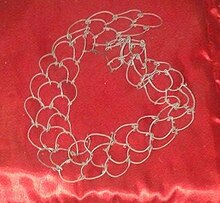Cilicio
A cilician is an accessory used to deliberately cause pain or discomfort to the wearer. Its use was widespread for a long time in the various Christian communities as a means of corporal mortification, thus seeking to combat temptations and, above all, identification with Jesus Christ in the sufferings he suffered in the Passion and the spiritual fruits that derive from it.
Historical usage
Traditionally, the cilicium was a shirt or tunic made of coarse cloth or animal hair. Its name derives from the Latin cilicium, a cloak made of goat's hair from Cilicia, a Roman province in southeastern Asia Minor; it could also be used as a sash around the waist or belly. Burlap, often mentioned in the New Testament as a symbol of mourning and penance, was used in the same way; similar was also the camel hair garment worn by Saint John the Baptist. The earliest recorded use of the term is in Psalm 34 of the Vulgate of St. Jerome of Strydon (Psalms 35:13 in Protestant editions), what does it say
Ego autem, cum mihi molesti essent, induebar cilicio.
The old version of the Reina-Valera translates it into Spanish as sack; the modern one says rough clothes, while the New American Standard Bible uses the term sackcloth.
Other Old Testament verses demonstrate its use as a mourning garment in ancient Israel (Genesis 34, Genesis 37, or 1 Kings 21, 27 among others).
In primitive Christianity, the use of cilicio to mortify the flesh became very frequent among ascetics, penitents, and those worldly characters who sought to expiate the luxury and comfort prohibited by the biblical mandate (Matthew 19) and fasting (Matthew 6:16).
Saint Jerome mentions the use of cilicio among Saints of the first centuries such as Saint Athanasius, John Damascene and Theodoret. At the same time, Saint Cassian of Imola disapproved of its use, stating that it satisfied the vanity of those who mortified themselves, and that it hindered its application to manual work. In the rule of Saint Benedict of Nursia the use of the cilicium is not mentioned, but the S. Benedictus illustratus, sive Disquisitionsum monasticarum libri XII, quibus S.P. Benedict van Häften's Benedicti Regula et religiorum rituum antiquitates varie elucidantur, written in the 17th century, argues that it was prevalent in the early stage of the order.
In the time of St. Augustine of Hippo, baptized adults symbolically wore cilicio during part of the ceremony. In the Middle Ages, most monastic orders adopted its use; The practice of making it out of thin wires dates from this time, to increase discomfort. The penitents dressed it during Ash Wednesday, and the altar of the church was covered with a cloth of this material during Lent.
Current use
Modernly, only a few commands continue to use it; the Carthusians and the Carmelites are the only ones who prescribe their use in the rule, while in other orders the cilice and the disciplines are reserved for voluntary or individually prescribed use. Instead of the hair or metal shirt, a metal chain or belt with spikes is also used, which is tied firmly to the thigh or armpit; the wounds caused by the cilicium do not lead to bleeding but leave visible marks. In Opus Dei, the recommendation to numeraries is to use it daily for two hours, with the exception of Sundays and holidays.
Contenido relacionado
Monastery of mendicant orders
Vera Cruz (Christianity)
Orthodox Christianity
Bible students
Liturgical books

